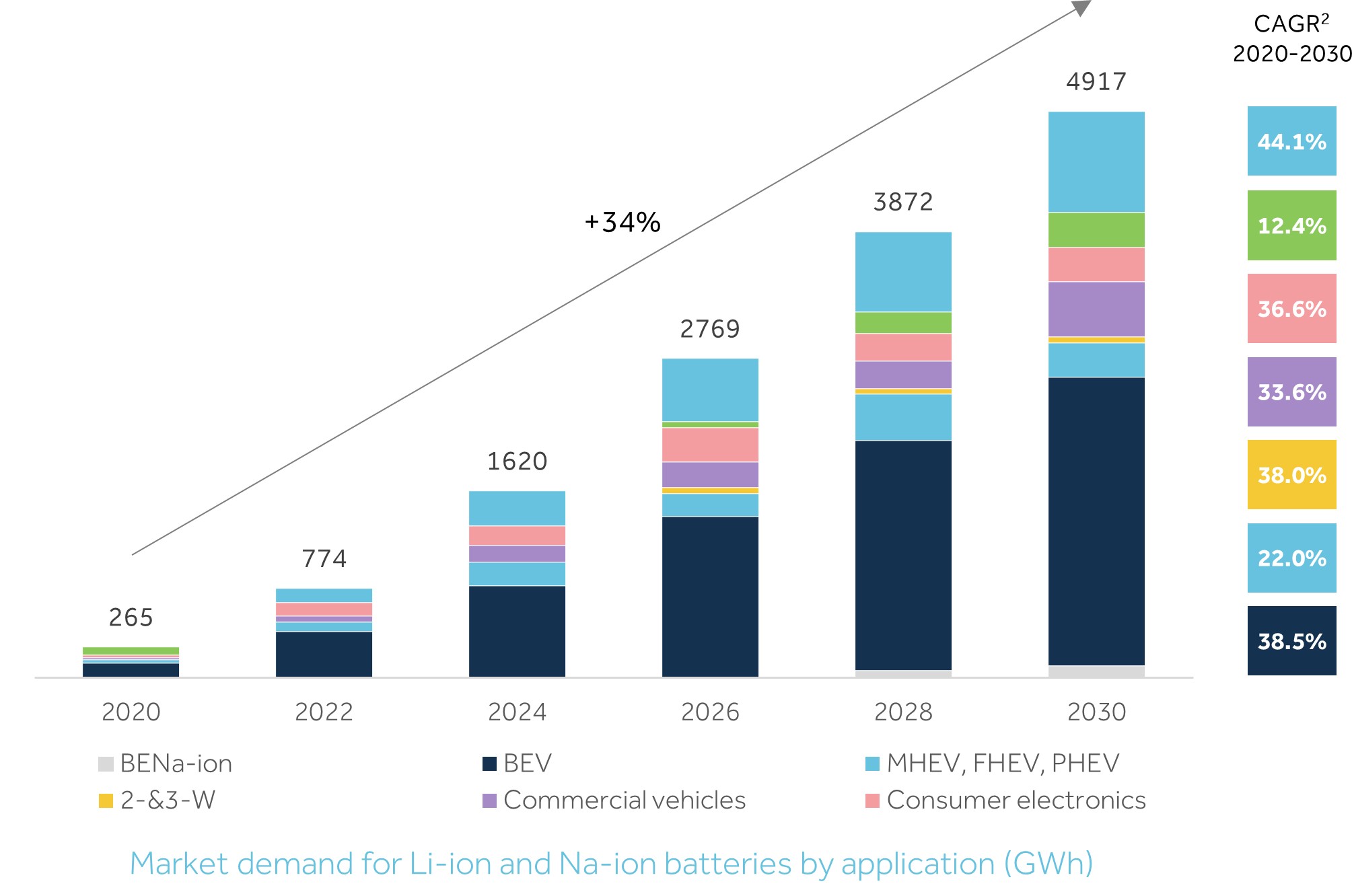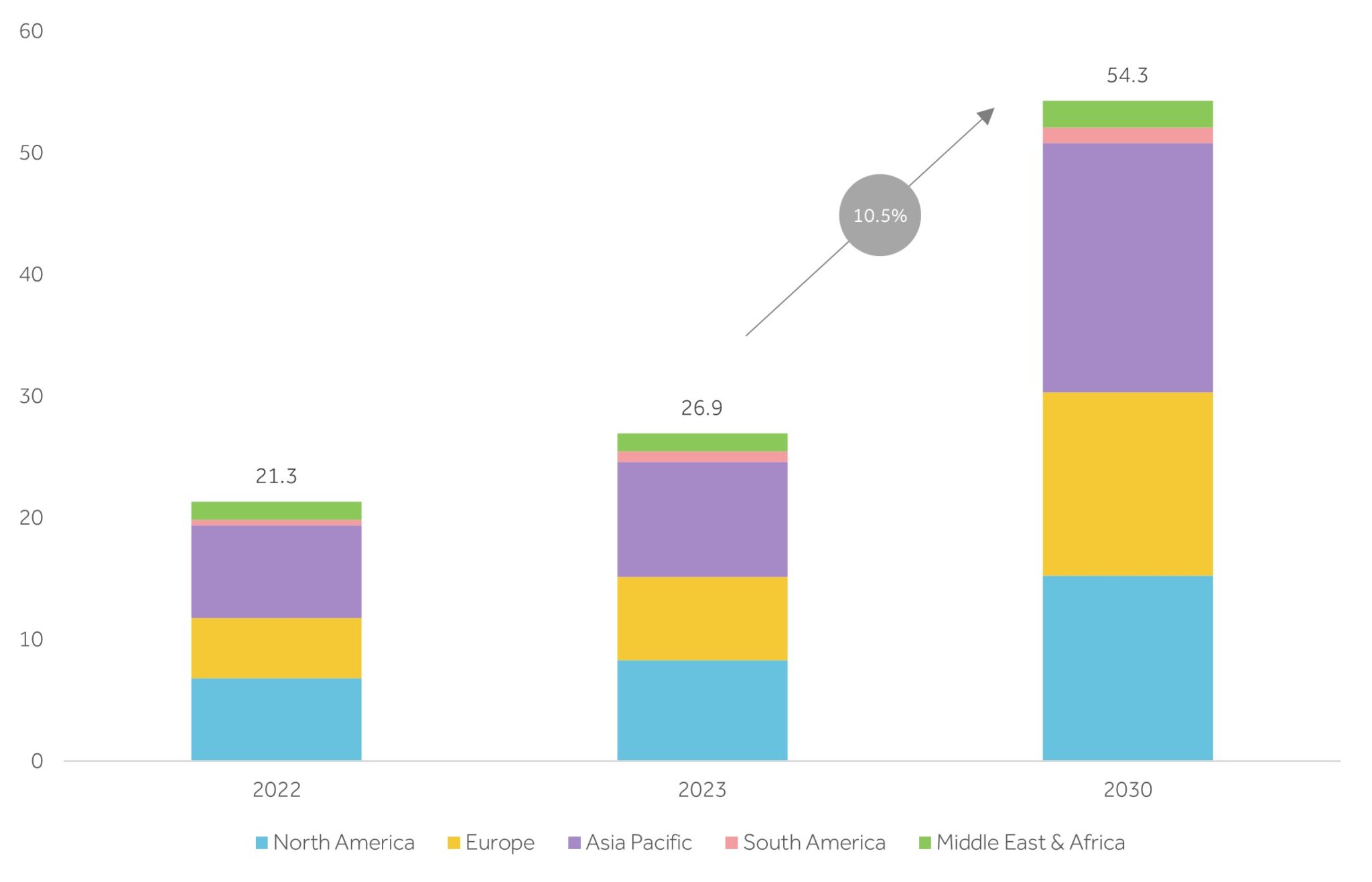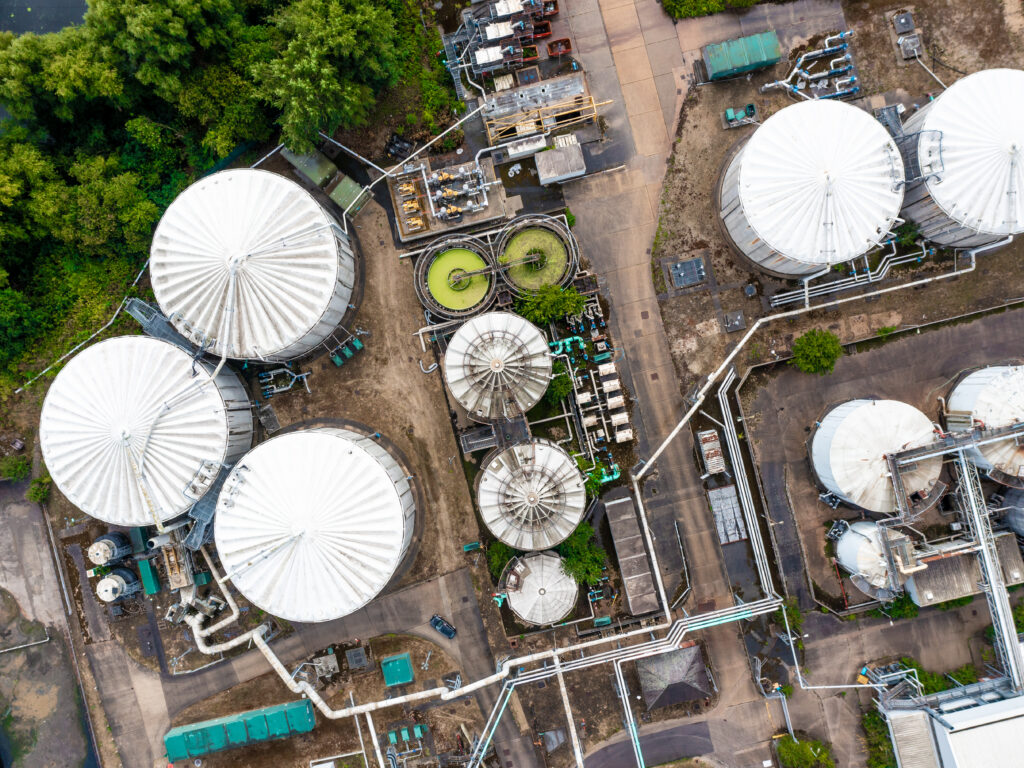
Introduction
As global demand for renewable energy and electric vehicles surges, the need for sustainable battery solutions has become increasingly urgent. Lithium-ion batteries, pivotal to everything from smartphones to electric vehicles, are central to this energy transformation. However, their manufacturing and disposal pose significant environmental challenges.
Enter the circular battery economy, a pioneering strategy that revolutionizes the battery lifecycle. Emphasizing reuse, recycling, and repurposing, this model not only reduces waste but also enhances resource efficiency. It represents a paradigm shift, turning current battery waste into future valuable energy resources.
The Importance of Batteries in Modern Society
Valued at USD 120.74 billion in 2023, the global battery market is rapidly ascending, projected to grow annually at a robust rate of 15.4% in the foreseeable future. Batteries have evolved into indispensable components of daily life and play a pivotal role in the ongoing energy transition. Here’s how they are driving change:
- Electronics: Batteries power the smartphones in our pockets, the laptops we work on, and critical medical devices, ensuring our interconnected world functions seamlessly.
- Electric Vehicles: By powering EVs, batteries are propelling us away from fossil fuels towards a cleaner, more sustainable transportation future.
Despite their transformative impact, the conventional battery lifecycle—from raw material extraction to disposal—imposes significant environmental and economic burdens. This unsustainable model underscores the urgent need for innovative solutions that can turn these challenges into opportunities.”

1. Na-ion base case penetration; 2. BEV, 2-& 3-W and ESS CAGR including Na-ion demand; abbreviations: BEV: Battery Electric Vehicle; MHEV, FHEV, PHEV: Mild Hybrid, Full Hybrid and Plug-in Hybrid Electric Vehicle; Light Vehicle: Passenger cars and light commercial vehicles with up to 6 tons; LSEV: Low Speed Electric Vehicle; 2W: Electric Two Wheelers.
Environmental and Economic Challenges
As global demand for batteries continues to surge, we must confront the formidable environmental and economic challenges inherent in their lifecycle:
 Given these challenges, embracing the circular battery economy emerges as a pivotal pathway forward. This approach aims to mitigate environmental impacts, enhance resource efficiency, and promote sustainable practices across the battery lifecycle.”
Given these challenges, embracing the circular battery economy emerges as a pivotal pathway forward. This approach aims to mitigate environmental impacts, enhance resource efficiency, and promote sustainable practices across the battery lifecycle.”
The Concept of Circular Economy
In today’s sustainability-driven world, the concept of a circular economy represents a groundbreaking departure from the traditional ‘take-make-dispose’ model. This innovative approach aims to optimize the utility and value of products, components, and materials by ensuring they remain in circulation for as long as possible.
When applied to batteries, the principles of a circular economy take on paramount importance. Initially, it entails designing batteries with durability and reusability as central tenets, extending their lifecycle and curbing the demand for new materials, thereby minimizing waste.
Efficient recycling forms another cornerstone of the circular battery economy, necessitating cutting-edge technologies to recover valuable materials such as lithium, cobalt, and nickel from spent batteries. This not only mitigates environmental impacts associated with mining but also reduces reliance on finite resources.
Furthermore, embracing second-life applications for batteries that no longer meet initial performance standards enhances resource efficiency. By repurposing these batteries for less demanding roles, they continue to deliver value and contribute to waste reduction.
Adopting the principles of the circular battery economy not only addresses environmental challenges but also sparks innovation throughout the industry. It fosters a sustainable balance where resource conservation, environmental responsibility, and economic efficiency converge, shaping a more resilient future for energy storage and beyond.”
Key Components of a Circular Battery Economy
Designing batteries for longevity involves strategic engineering aimed at extending their life cycles, thereby reducing the frequency of replacement and minimizing waste generation. This comprehensive approach encompasses:
 Second-life applications are critical for batteries that no longer meet stringent performance requirements in electric vehicles (EVs) or other demanding roles. These applications include:
Second-life applications are critical for batteries that no longer meet stringent performance requirements in electric vehicles (EVs) or other demanding roles. These applications include:
 By integrating these strategies, businesses can not only optimize battery performance and durability but also contribute significantly to sustainability goals by minimizing environmental impact and maximizing resource efficiency.
By integrating these strategies, businesses can not only optimize battery performance and durability but also contribute significantly to sustainability goals by minimizing environmental impact and maximizing resource efficiency.
Benefits of a Circular Battery Economy
Implementing a circular battery economy presents a plethora of environmental and economic benefits.
Environmentally, this approach significantly diminishes resource extraction by optimizing the recycling and reuse of materials, thereby mitigating environmental degradation associated with mining. Additionally, it reduces emissions throughout the entire battery lifecycle, from production to disposal, promoting a cleaner and more sustainable energy ecosystem. By minimizing battery waste in landfills, it also prevents soil and water contamination, thus protecting natural ecosystems.
From an economic standpoint, the advantages are equally compelling. Recovering valuable materials from used batteries not only lowers production costs by decreasing the need for new raw materials but also stimulates economic growth through the creation of new industries focused on recycling and repurposing technologies. This innovation-driven approach generates employment opportunities and enhances resource security by reducing dependence on imported raw materials, thereby strengthening economic stability and resilience.
A circular battery economy delivers both environmental stewardship and economic prosperity through efficient resource utilization and pioneering practices in battery management.
Challenges to Implementing a Circular Battery Economy
Transitioning to a circular battery economy, while promising significant benefits, comes with challenges across technical, economic, and social fronts:
Technical Challenges
- Recycling Efficiency: Existing recycling technologies are not completely efficient, necessitating ongoing research to improve recovery rates.
- Second-Life Performance: Ensuring that repurposed batteries perform reliably in new applications requires stringent testing and certification.
Economic Challenges
- High Initial Costs: Significant investment is required to establish recycling facilities and develop advanced technologies.
- Market Development: Creating viable markets for second-life batteries and recycled materials is crucial for the economic sustainability of the circular economy.
- Incentives and Regulations: Effective policies and incentives are essential to incentivize companies to adopt circular practices.
Social and Policy Challenges
- Consumer Awareness: Educating consumers about the benefits of battery recycling and repurposing is vital for widespread adoption.
- Global Collaboration: International cooperation is necessary to ensure sustainable sourcing and efficient recycling practices in the circular battery economy.
- Regulatory Frameworks: Governments play a key role in developing and enforcing regulations that support circular economy initiatives.
In essence, while the circular battery economy holds promise for a more sustainable future, navigating these multifaceted challenges will be key to realizing its full potential and ensuring widespread adoption.
Case Studies and Innovative Initiatives in the Circular Battery Economy
Advancements in the circular battery economy are paving the way for a more sustainable future, driven by innovative practices and proactive governmental leadership.
Corporate Innovations:
- Tesla’s Battery Recycling: At the forefront, Tesla has developed cutting-edge recycling capabilities to reclaim valuable materials from its batteries. This initiative aims to establish a circular system, where materials are reused to reduce dependency on new resource extraction.
- Northvolt’s Revolt Program: In Europe, Northvolt’s Revolt program focuses on recycling lithium-ion batteries to recover critical materials. This effort not only supports sustainable resource management but also drives advancements in recycling technologies.
Government Initiatives:
- Netherlands’ Extended Producer Responsibility (EPR) Scheme: The Netherlands leads with its EPR scheme for batteries, mandating producers to manage the collection and recycling of used batteries. This initiative ensures high recovery rates of materials through rigorous recycling standards and transparent reporting, aligning with the country’s Circular Economy Strategy aimed at achieving full circularity by 2050.
- Australia’s Battery Stewardship Scheme: In Australia, the national Battery Stewardship Scheme is boosting battery recycling rates by fostering collaboration across industries. This initiative involves manufacturers, retailers, and recyclers to build a strong infrastructure for collection and recycling. It features consumer incentives, certified recyclers, and public awareness campaigns aimed at encouraging responsible battery disposal and recycling practices.
These initiatives not only exemplify commitment to environmental stewardship but also drive economic opportunities and technological advancements in sustainable battery management. By fostering collaboration between industry leaders and governments, they pave the way for a circular economy.
The Promising Future of the Circular Battery Economy
The future of the circular battery economy looks promising, propelled by advancements in technology, forward-thinking policies, and evolving market dynamics. Significant trends and developments indicate a transformative path ahead:
 The global battery recycling market, valued at USD26.9 billion in 2023, is projected to climb to USD54.3 billion by 2030, growing at a robust CAGR of 10.5%. This growth trajectory is fueled by increasing investments in electric vehicles, stringent environmental regulations, and government initiatives promoting battery recycling. Collectively, these factors are positioned to elevate the circular battery economy into a pivotal role in achieving sustainable energy solutions for a greener tomorrow.
The global battery recycling market, valued at USD26.9 billion in 2023, is projected to climb to USD54.3 billion by 2030, growing at a robust CAGR of 10.5%. This growth trajectory is fueled by increasing investments in electric vehicles, stringent environmental regulations, and government initiatives promoting battery recycling. Collectively, these factors are positioned to elevate the circular battery economy into a pivotal role in achieving sustainable energy solutions for a greener tomorrow.

Conclusion
The concept of a circular battery economy offers a compelling solution to the dual challenges of environmental impact and economic sustainability associated with conventional battery lifecycles. Emphasizing durable design, efficient recycling processes, and the exploration of second-life applications, this approach not only reduces environmental footprints but also unveils new economic opportunities. However, realizing the full potential of a circular battery economy necessitates innovative solutions, substantial investment, and global collaboration to surmount technical, economic, and societal barriers.
As the world increasingly transitions towards renewable energy and electric mobility, embracing a circular battery economy is crucial for achieving sustainability objectives and paving the way for a cleaner, more sustainable future.
References
- IEA (May 2024)
- Anavo (May 2024)
- Polaris Market Research (Jan 2024)
- Netherlands Enterprise Agency (Nov 2023)
- B-cycle (Nov 2023)
- Markets and Markets (June 2023)
- United Nations (Mar 2023)
- Northvolt (2022)
- Tesla (Nov 2021)



